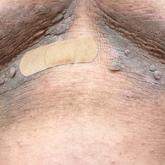Article

Hyperpigmented Flexural Plaques, Hypohidrosis, and Hypotrichosis
- Author:
- India A. Loyd, MD, MPH
- Amanda S. Weissman, MD
- Jarad Levin, MD
A 61-year-old woman with a history of hypohidrosis and deafness presented with a pruritic rash on the neck and antecubital fossae of several years...
